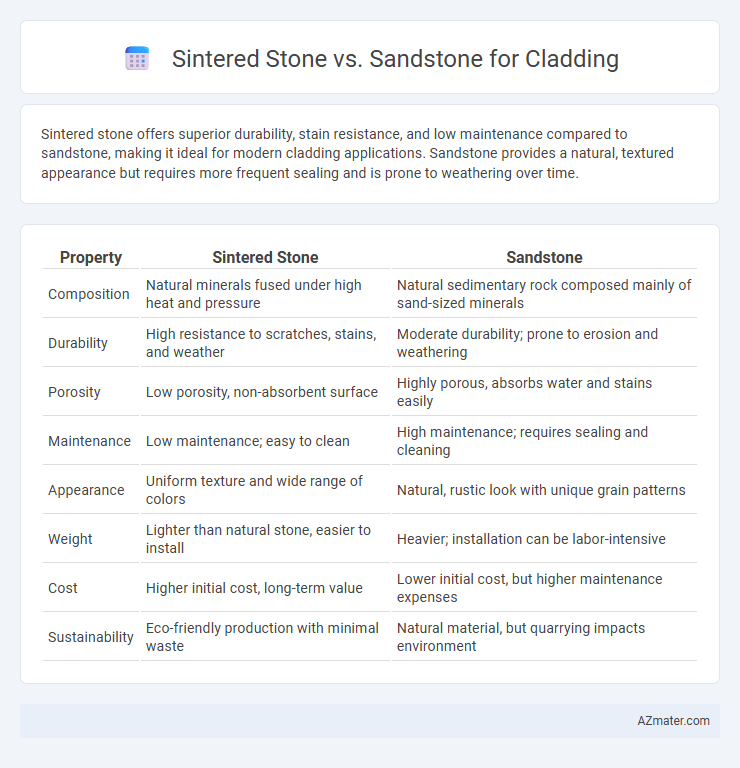Sintered stone offers superior durability, stain resistance, and low maintenance compared to sandstone, making it ideal for modern cladding applications. Sandstone provides a natural, textured appearance but requires more frequent sealing and is prone to weathering over time.
Table of Comparison
| Property | Sintered Stone | Sandstone |
|---|---|---|
| Composition | Natural minerals fused under high heat and pressure | Natural sedimentary rock composed mainly of sand-sized minerals |
| Durability | High resistance to scratches, stains, and weather | Moderate durability; prone to erosion and weathering |
| Porosity | Low porosity, non-absorbent surface | Highly porous, absorbs water and stains easily |
| Maintenance | Low maintenance; easy to clean | High maintenance; requires sealing and cleaning |
| Appearance | Uniform texture and wide range of colors | Natural, rustic look with unique grain patterns |
| Weight | Lighter than natural stone, easier to install | Heavier; installation can be labor-intensive |
| Cost | Higher initial cost, long-term value | Lower initial cost, but higher maintenance expenses |
| Sustainability | Eco-friendly production with minimal waste | Natural material, but quarrying impacts environment |
Introduction to Cladding Materials
Sintered stone and sandstone are prominent choices for cladding materials due to their durability and aesthetic appeal. Sintered stone, made through high-temperature fusion of natural minerals, offers enhanced resistance to weathering, stains, and scratches. Sandstone, a sedimentary rock composed primarily of quartz and feldspar, provides a natural, textured look but requires sealing to maintain its longevity when used as exterior cladding.
What is Sintered Stone?
Sintered stone is an engineered material made by compacting natural minerals under extreme heat and pressure, resulting in a highly durable, non-porous surface ideal for cladding. Unlike sandstone, which is a sedimentary rock formed through natural compression of sand particles, sintered stone offers superior resistance to scratches, stains, and weathering. This makes sintered stone a preferred choice for exterior and interior cladding where long-lasting performance and aesthetic appeal are essential.
What is Sandstone?
Sandstone is a natural sedimentary rock composed primarily of sand-sized mineral particles, predominantly quartz and feldspar, known for its durability and natural aesthetic in cladding applications. It offers excellent weather resistance and a unique, earthy texture that enhances architectural facades with a timeless look. Compared to sintered stone, sandstone requires more maintenance but provides superior breathability and a natural patina that develops over time.
Aesthetic Differences: Sintered Stone vs Sandstone
Sintered stone offers a sleek, uniform appearance with a wide range of colors and finishes, providing a modern and polished aesthetic for cladding applications. Sandstone features natural grain patterns and earthy hues, delivering a warm, rustic charm that emphasizes organic texture and variation. The choice between sintered stone and sandstone hinges on whether a contemporary or traditional aesthetic is desired for building facades.
Durability and Weather Resistance
Sintered stone exhibits superior durability and weather resistance compared to sandstone, making it ideal for cladding applications in harsh environments. Its manufacturing process creates a dense, non-porous surface resistant to UV rays, frost, and chemical damage, whereas sandstone is more porous and susceptible to erosion and staining. This enhanced resilience of sintered stone ensures longer-lasting facades with less maintenance in exterior cladding projects.
Maintenance Requirements
Sintered stone requires minimal maintenance due to its non-porous surface, which resists stains, scratches, and UV damage, making it ideal for long-lasting cladding with minimal cleaning. Sandstone, being porous and softer, demands regular sealing and more frequent cleaning to prevent weathering, staining, and surface degradation when used as cladding. Choosing sintered stone reduces long-term maintenance efforts and costs compared to the higher upkeep needed for sandstone cladding.
Cost Comparison
Sintered stone typically bears a higher initial cost compared to sandstone due to its advanced manufacturing process and enhanced durability. Sandstone offers a more budget-friendly option but may incur higher long-term maintenance expenses because of its porous nature. Evaluating total lifecycle costs, sintered stone can provide better value through reduced upkeep and extended lifespan despite the upfront investment.
Environmental Impact and Sustainability
Sintered stone offers superior environmental benefits compared to sandstone, as it is produced through a process that involves minimal natural resource extraction and incorporates recycled materials, reducing overall ecological footprint. Sandstone quarrying causes significant landscape disruption and habitat loss, whereas sintered stone manufacturing emphasizes energy efficiency and lower water consumption. Choosing sintered stone for cladding supports sustainability goals by promoting longevity, recyclability, and reduced carbon emissions throughout its lifecycle.
Installation Practices and Challenges
Sintered stone cladding offers a lightweight and durable solution that simplifies installation through large, thin panels requiring minimal structural support, while sandstone typically involves heavier, thicker slabs demanding robust anchoring and more labor-intensive handling. The precision manufacturing of sintered stone allows for consistent thickness and sizes, reducing fitting errors and installation time compared to the natural variability of sandstone. Challenges with sandstone include increased risk of cracking during installation and the need for skilled masons to ensure proper alignment and fastening, contrasting with the easier modular system integration of sintered stone panels.
Which is Better for Cladding: Sintered Stone or Sandstone?
Sintered stone offers superior durability, stain resistance, and low porosity compared to sandstone, making it more suitable for exterior cladding where weather exposure is significant. Sandstone provides natural aesthetic appeal and breathability but is more prone to erosion and requires regular maintenance for optimal performance. For cladding applications demanding longevity and minimal upkeep, sintered stone is generally the better choice, while sandstone suits projects prioritizing traditional, natural textures.

Infographic: Sintered stone vs Sandstone for Cladding
 azmater.com
azmater.com